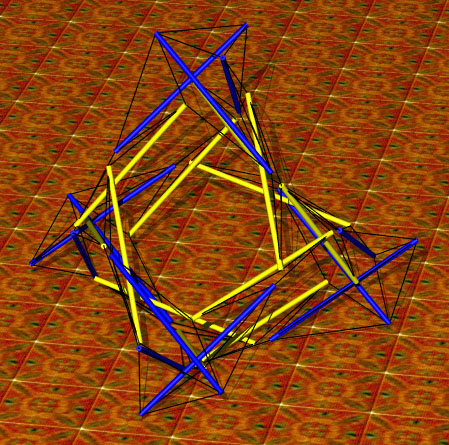

Here's a computer rendering (using POV-Ray) of another single-layer tensegrity I designed on December 3, 1987, and revised April 16, 2003. It also uses a 4ν breakdown of the tetrahedron with a diamond topology. This time I made all the strut lengths equal, though I've given the two types of struts different colors in the rendering above. (The structure you saw in the previous frame has struts of two different lengths.) The main addition here was another iteration layer so that the four struts which form a sort of minor circle about each edge of the tetrahedron are co-planar.
My original 1987 effort at aligning the struts into a single plane came close, but since I zeroed just two of the necessary three determinants, it wasn't quite there. The struts ended up forming a slightly-creased rhombus. Now I think I've got it right. Since the cluster of four struts corresponds to an edge of the tetrahedron, every one of the 24 struts is contained in one of the six rhombus-like planar clusters, and they fall in the planes of the tetrahedron's sister polyhedron, the cube. At two corners of the rhombus, the adjacent struts are very close together. At the other two corners, there is a rather large gap between the adjacent struts. The rhombus alternates yellow and blue struts.
Originally, I didn't have visualization built into my tensegrity software, or at least it wasn't sufficient to spot my problem. Back then, the struts seemed a bit out of alignment when I put it together, but I attributed it to modeling error. I realized my error years later when I went back to this figure and saw the computer-generated version looked like it had the same slight misalignment. I plan to assemble an example of the revised version. It has certainly been a source of a good amount of perplexity for me.
In the above view, there are two rhombus planes which are almost edgewise to the viewer. The edges slant left to right as you move from the top to the bottom of the picture. The floor pattern is from a ceramic tile in one of the Egyptian galleries at Boston's Museum of Fine Arts. This structure is also available for interactive viewing on the Tensegrity Viewer (see "4v Diamond Tetra (aligned)") where you might find the alignment easier to see. It's not too hard to bring it around so you can look down the cubic axes. Then you'll see some of the struts forming a square.


